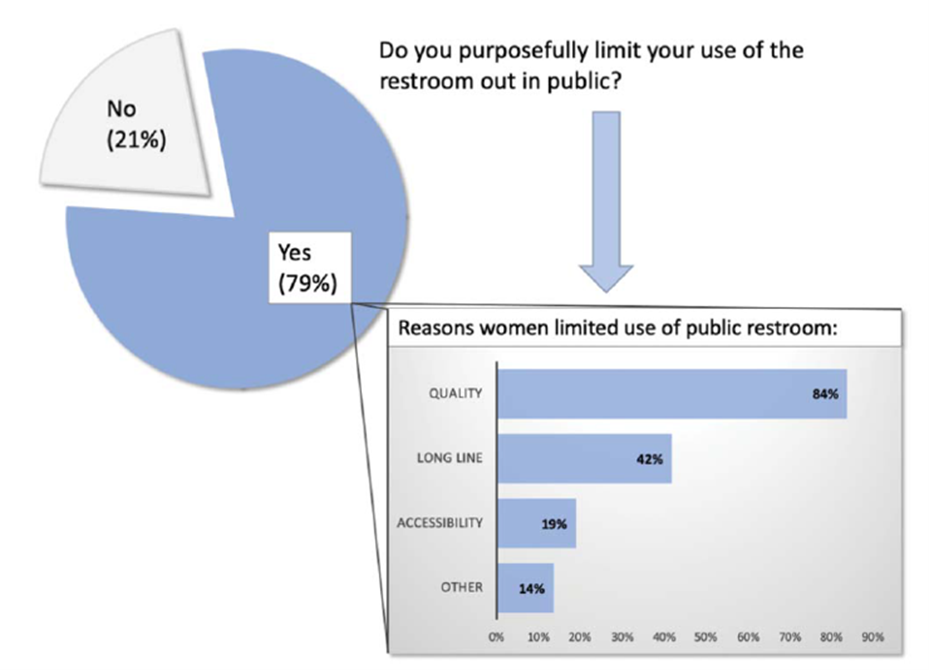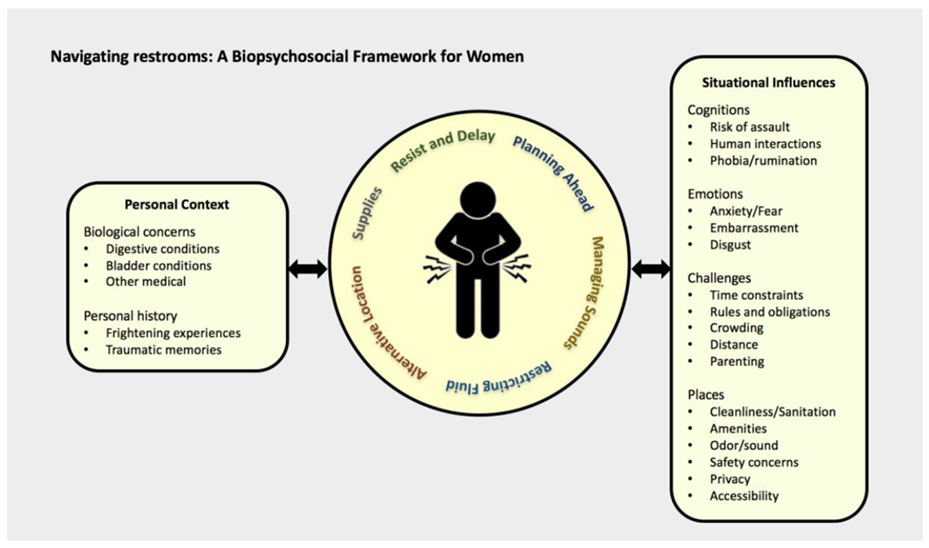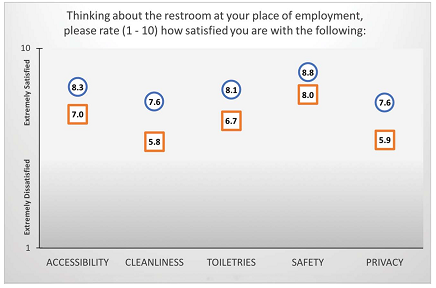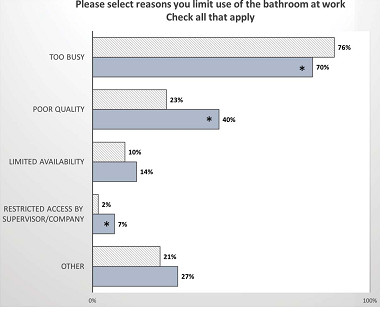Toilet environments and restroom access
This research examines how individuals interact with restrooms and toilet environments, including how limited or restricted access to restrooms affects urinary symptoms and conditions, and behaviors.

Figure 2. Proportion of women who avoid public restrooms and reasons why. From Reynolds et al, The Journal of Urology, 2020.
Figure 2. Mean VAS satisfaction scores of factors associated with work restrooms by whether women limited restroom use while at work (squares) or not (circles). From Reynolds et al, The Journal of Urology, 2019.
Figure 3. Reasons why women working full time limited restroom use at work if they limited use at all. Items were only assessed in 1,668 subjects who did not answer “not at all.” Asterisk indicates significantly different (p<0.001). Hatched bars indicate occasionally or sometimes limited. Gray bars indicate limited most or all of the time. From Reynolds et al, The Journal of Urology, 2019.

Figure 1. A biopsychosocial framework for women navigating restrooms. From Hartigan et al, International Journal of Environmental Research and Public Health, 2020.
Selected Publications
Kowalik CG, Daily A, Delpe S, Fowke J, Kaufman MR, Dmochowski RR, Reynolds WS. (2019) Toileting behaviors of adult women: What is healthy? Journal of Urology. 201(1):129-134. PMID: 30053511. PMCID: PMC6309941
Reynolds WS, Kowalik CG, Delpe S, Fowke J, Kaufman MR, Dmochowski RR (2019). Toileting behaviors and bladder symptoms in women who limit restroom use at work: a cross-sectional study. The Journal of Urology; 202(5):1008-1014 PMID: 31059664 PMCID: PMC6832766
Daily A, Kowalik CG, Delpe S, Kaufman MR, Dmochowski RR, Reynolds WS (2019). Women with overactive bladder exhibit more unhealthy toileting behaviors: a cross-sectional study. Urology; 134:97-102. PMID: 31499079 PMCID: PMC6924631
Reynolds WS, Kowalik CG, Kaufman MR, Dmochowski RR, Fowke J (2020). Women’s perceptions of public restrooms and the relationships with toileting behaviors and bladder symptoms: a cross-sectional study. The Journal of Urology. [Epub Feb 25, 2020]. PMID: 32096679. PMCID: PMC7354199.
Hartigan S, Bonnet K, Chisholm L, Kowalik C, Dmochowski RR, Schlundt D, Reynolds WS (2020). Why do women not use the bathroom? Women’s attitudes and beliefs on using public restrooms. International Journal of Environmental Research and Public Health; 17(6): 2053. [Epub March 20, 2020]. PMID: 32244871, PMCID: PMC7142493.
Hartigan, S, Finn M, Dmochowski RR, Reynolds WS (2021). Real-time daily assessment of work interference on healthcare professionals' restroom use: a pilot study. Neurourology and Urodynamics; 40(2):728-734. PMID: 33616293, PMCID: PMC7905752
Reynolds WS, Kaufman MR, Bruehl S, Dmochowski RR, McKernan LC (2021). Compensatory Bladder Behaviors (“Coping”) in Women with Overactive Bladder. Neurourology and Urodynamics. [Epub September 15, 2021]. PMID: 34524704. PMCID: in process.
Brady SS, Bavendam TG, Bradway CK, Conroy B, Dowling-Castronovo A, Epperson CN, Hijaz AK, Hsi RS, Huss K, Kim M, Lazar J, Lee RK, Liu CK, Loizou CN, Miran S, Mody L, Norton JM, Reynolds WS, Sutcliffe S, Zhang N, Hokanson JA (2021). Noncancerous Genitourinary Conditions as a Public Health Priority: Conceptualizing the Hidden Burden. Urology; [Epub 2021 Sep 15]. PMID: 34536410.


